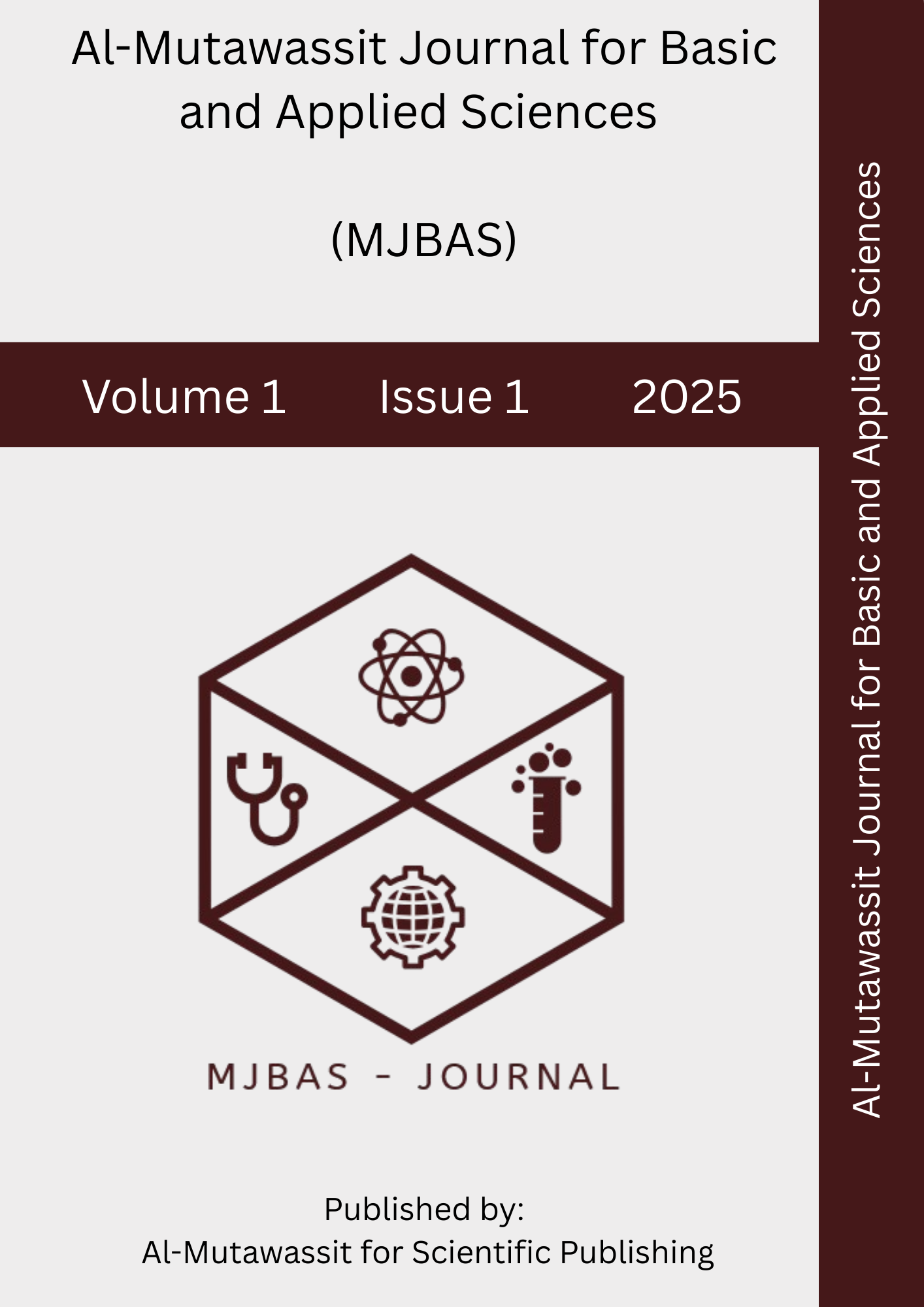تعزيز الصيدلة الخضراء من خلال أنظمة توصيل الأدوية القابلة للتحلل الحيوي للحد من التلوث الدوائي وتعزيز النتائج العلاجية
الكلمات المفتاحية:
البوليمرات القابلة للتحلل الحيوي، الصيدلة الخضراء، التلوث الدوائي، الإطلاق المُتحكم به، PLGA، كرات PLGA الدقيقة، توصيل الأدوية، الاستدامة البيئية، منع التلوثالملخص
تواجه صناعة الأدوية تحديًا متزايدًا يتمثل في التلوث البيئي الناجم عن دخول مركبات دوائية ثابتة إلى النظم البيئية. يسعى مفهوم "الصيدلة الخضراء" إلى إيجاد حلول مستدامة من خلال إعادة تصميم المنتجات الدوائية وآليات توصيلها للحد من تأثيرها البيئي. وتُعد أنظمة توصيل الأدوية القابلة للتحلل الحيوي (DDS) ابتكارًا رئيسيًا في هذا المسعى. تستخدم هذه الأنظمة بوليمرات قابلة للتحلل الحيوي (مثل PLA وPLGA وPCL والبوليمرات الحيوية الطبيعية) لتغليف المكونات الفعالة وإطلاقها بطريقة مُحكمة، ثم تتحلل إلى منتجات غير ضارة (مثل ثاني أكسيد الكربون والماء). تستعرض هذه الورقة البحثية التطورات الحديثة في أنظمة توصيل الأدوية القابلة للتحلل الحيوي ودورها في الحد من التلوث الدوائي. أولًا، تُلخص الورقة أدلة على انتشار التلوث الدوائي في المجاري المائية والمخاطر البيئية الناجمة عنه. ثم تُقدم مفهوم الصيدلة الخضراء والفوائد البيئية للناقلات القابلة للتحلل الحيوي. نناقش البوليمرات القابلة للتحلل الحيوي الشائعة، وآليات تحللها، وكيف تؤثر عوامل التصميم (نوع البوليمر، وحجم الجسيمات، وكيمياء السطح) على إطلاق الدواء ومعدل تحلله. نُسلِّط الضوء على دراسات حالة: على سبيل المثال، خيوط PLA/PGA ومستودعات أدوية PLGA التي تُوفِّر علاجًا مُطوَّلًا دون هدر مُستمر. ومن الأمثلة السريرية البارزة رقائق الكارمستين القابلة للتحلل الحيوي (Gliadel) المُستخدَمة لعلاج أورام الدماغ، والتي حسَّنت بشكل ملحوظ بقاء المرضى على قيد الحياة مع تحللها في النهاية داخل الجسم الحي. كما تُحسِّن مُركَّبات DDS القابلة للتحلل الحيوي العلاجَ من خلال إطلاقها المُستدام وتوصيلها المُوجَّه، مما يُقلِّل من تواتر الجرعات والآثار الجانبية. تتناول الورقة البحثية الدراسات التجريبية للكرات الدقيقة والأغشية القابلة للتحلل الحيوي التي تُوصِل أدوية مُضادة للسرطان والمضادات الحيوية ومضادات الالتهاب، مُشيرةً إلى تحسُّن النتائج وتقليل المخلفات. تشمل التحديات توسيع نطاق التصنيع، وضمان استمرارية التحلل، والعقبات التنظيمية. وتخلص المراجعة إلى أن دمج مُركَّبات DDS القابلة للتحلل الحيوي في تطوير الأدوية يُمثِّل مسارًا واعدًا للأدوية "الخضراء" التي تُشفي المرضى دون الإضرار بالبيئة.
المراجع
1. Boxall, A. B. A., Peterson, B. J., et al. (2022). Pharmaceutical pollution of the world’s rivers. Proc. Natl. Acad. Sci. U.S.A., 119(8), e2113947119.
2. Brannon-Peppas, L. (1995). Recent advances on the use of biodegradable microparticles and nanoparticles in controlled drug delivery. Int. J. Pharm., 116(1-2), 1-9.
3. Brannon-Peppas, L. (2009). Poly(lactic-co-glycolic) acid as a carrier for imaging contrast agents. J. Biomed. Mater. Res. Part B Appl. Biomater., 90(1), 165-175.
4. Salwa Muftah Eljamay, Mohammed Marri Younus, & Fatma Muftah Eljamay. (2023). Side Effects of Receiving Different Types of COVID-19 Vaccines. Libyan Journal of Contemporary Academic Studies, 1(1), 54-65.
5. Nabil Saad Miftah (2025). Pharmacovigilance and Adverse Drug Reaction Patterns: A Data-Driven Study on Drug Safety in Clinical Practice. Journal of Insights in Basic and Applied Sciences, 1(1), 27-34.
6. Kamaly, N., Yameen, B., Wu, J., & Farokhzad, O. C. (2016). Degradable controlled-release polymers and polymeric nanoparticles: mechanisms of controlling drug release. Acc. Chem. Res., 49(2), 258-268.
7. Middleton, J. C., & Tipton, A. J. (2000). Synthetic biodegradable polymers as orthopedic devices. Biomaterials, 21(23), 2335-2346.
8. Shalem, A., Tang, F., et al. (2024). Enzymatic degradation of polylactic acid (PLA). Appl. Microbiol. Biotechnol., 108(1), 413.
9. Wafa Emrigha Abotabel. (2025). The Impact of the Gut Microbiome on Mental Health: Exploring Psychobiotics and the Microbiota–Gut–Brain Axis. Journal of Libyan Academy Bani Walid, 1(2), 150–160.
10. Su, Y., Zhang, B., Sun, R., Liu, W., Zhu, Q., Zhang, X., Wang, R., Chen, C. (2021). PLGA-based biodegradable microspheres in drug delivery: recent advances in research and application. Drug Deliv., 28(1), 1397-1418.
11. Westphal, M., Hilt, D., Bortey, E., Ram, Z., et al. (2003). A phase 3 trial of local chemotherapy with biodegradable carmustine (BCNU) wafers (Gliadel wafers) in patients with primary malignant glioma. Neuro-Oncology, 5(2), 79-88.
12. D’Souza, S. J. (2014). A science and business literature review of polymeric injectable depot systems. Int. J. Pharm., 475(1-2), 23-46.
13. U.S. FDA (2023). DEXON® Violet Polyglycolic Acid Suture (Procode 73GAM). Product Label and Approval History.
14. Nusaiba Abduladim Elmahjub (2025). Deep Learning for Early Detection and Classification of Diabetic Retinopathy in Clinical Practice. Libyan Open University Journal of Medical Sciences and Sustainability, 1(1), 11-19.
15. Iman Nsser Zew. (2025). Evaluation of Polycyclic Hydrocarbons Using Thermal Analysis and the Scientific and Biological Study of Isolated Bacteria Isolated from Contaminated Soil in Al-Zeit Street, (AL-Iraq Street), Benghazi, Libya. Journal of Libyan Academy Bani Walid, 1(2), 65–118.
16. Hamza Khalifa Ibrahim. (2025). Emerging Viral Threats in the Post-Pandemic Era: Surveillance, Climate Dynamics, and Global Health Preparedness. Libyan Journal of Health, Science, and Development (LJHSD), 1(1), 08-15.
17. Nagah Bobtina, Intesar Elmasli, Ali Bubteina, & Maryam Akhwater. (2025). The effect of risk factors, heredity and chronic diseases on property incidence of kidney disease. Journal of Libyan Academy Bani Walid, 1(2), 39–50.
18. Nabil Saad Miftah (2025). Transforming Healthcare Through Artificial Intelligence: From Predictive Diagnostics to Personalized Therapeutics. Libyan Open University Journal of Medical Sciences and Sustainability, 1(1), 37-44.
19. Nusaiba Abduladim Elmahjub (2025). Global Trends in Prescription Drug Utilization and Resistance Patterns: A 15-Year Comparative Study of Therapeutic Practices. Scientific Journal for Publishing in Health Research and Technology, 1(1), 26-34.
20. Hamza Khalifa Ibrahim (2025). Adverse Drug Reactions in Polypharmacy: A Real-World Pharmacovigilance Study Using EHR Data. (2025). Journal of Insights in Basic and Applied Sciences, 1(1), 10-19.
21. Mohamed Salem, & Ilyas Salem. (2025). Antimicrobial Polymers: Mechanisms of Action and Applications in Combating Antibiotic Resistance. Al-Imad Journal of Humanities and Applied Sciences (AJHAS), 1(1), 12-15.





